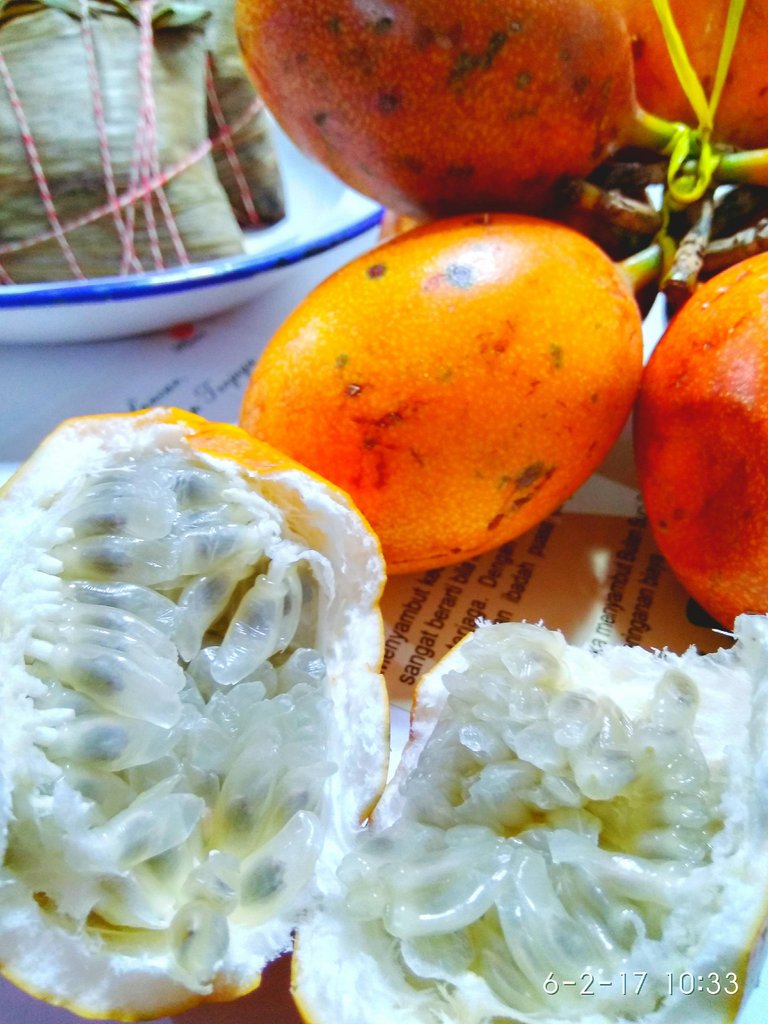
Passion fruit is a nutritious tropical fruit, a good source of nutrients (vitamin A, Folate, vitamin C, Calcium, Magnesium, Pottasium, and Phosporus) especially fiber (7% per serving), vitamin C and vitamin A.
It is is low in Sodium (5 mg per single fruit), Saturated Fat (0 gram) and Cholesterol (0 gram). But mostly the calories come from sugars.
The estimated glycemic load is 1 of typical target total of 100 per day.
Read More http://nutritiondata.self.com/facts/fruits-and-fruit-juices/1987/2#ixzz4j19RXimx
A granadilla (purple) passion fruit of about 18 grams contains:
Calories: 17
Cholesterol: 0% of the RDI
Sodium: 0% of the RDI
Fat: 0% of the RDI
Fiber: 7% of the RDI
Vitamin C: 9% of the RDI
Vitamin A: 5% of the RDI
Iron: 2% of the RDI
Potassium: 2% of the RDI
Carbohydrate: 1% of the RDI
It’s also rich in carotenoids and polyphenols.
The fruit has a tough rind and juicy, seed-filled center.
There are 5 main varieties of passioflora. The most commonly available are the purple and yellow varieties.
Passiflora edulis has small round or oval-shaped fruits with purple skin and yellow filling. The colour changes from green to deep purple when ripe.
Passiflora flavicarpa is usually slightly larger than the purple variety, with round or oval-shaped, white filling and yellow skin. The colour changes from green to yellow when ripe. Like the one in the picture.
In Indonesia, it is popular to have this fruit as beverage. The one with yellow flesh is processed as a fruit juice concentrate. While the white one can be eaten straight.
The pulp is filtered and the seeds are removed to be then cooked with sugar to make a concentrate.
To enjoy it, one should mix the concentrate with water and some ice. The sweet tangy and fragrant of the juice is really refreshing.
Source:
https://en.wikipedia.org/wiki/Passiflora_edulis
http://nutritiondata.self.com/facts/fruits-and-fruit-juices/1987/2
http://www.nafis.go.ke/fruits/passion-fruit/varieties/
Ansonsten: sieht echt lecker aus die Frucht! :)Hi, es wäre gut, die Quelle für die angegebenen Vitaminmengen einfach per Link direkt anzugeben, dann 'schimpft' auch @cheetah nicht. Hol das am besten nach.
danke :) habe ich gerade gelesen , mache ich jetzt die Korrektur
Hi! I am a robot. I just upvoted you! I found similar content that readers might be interested in:
https://authoritynutrition.com/passion-fruit/
Not indicating that the content you copy/paste is not your original work could be seen as plagiarism.
Some tips to share content and add value:
Repeated plagiarized posts are considered spam. Spam is discouraged by the community, and may result in action from the cheetah bot.
Creative Commons: If you are posting content under a Creative Commons license, please attribute and link according to the specific license. If you are posting content under CC0 or Public Domain please consider noting that at the end of your post.
If you are actually the original author, please do reply to let us know!
Thank You!
thank you for the heads up
I've always loved passionfruit for their flavor. They have this perfect balance between sweet and tart, something that most other fruit don't even come close to.
But yes, they are still pretty high in sugar.